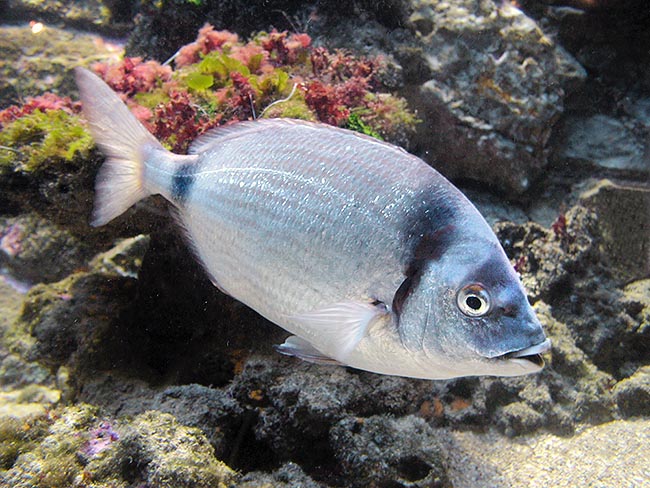Family : Sparidae

Text © Giuseppe Mazza

English translation by Mario Beltramini

The Twoband bream (Diplodus vulgaris) loves sandy bottoms with rocks around © Giuseppe Mazza
The name of the genus come from the Greek “diplous” = two, and “odous” = tooth, therefore “double tooth”, with reference to the incisors, present on both jaws.
The name of the species comes from the Latin “vulgaris” = common, and, as a matter of fact, it is quite easy to fish.
Zoogeography
It is very frequent in the entire Mediterranean basin, and, beyond the Gibraltar Strait, it is found on the Atlantic coast, northwards up to England, and southwards up to South Africa, including the Azores, Madeira, Canary and Cape Verde Islands. After the Cape of Good Hope, it goes northward for a while along the Indian Ocean coasts.
Ecology-Habitat
The scenery preferred by the common two-banded seabream is a nice sandy seabed with a rock amidst. It adapts also to the rocky seabeds, but less than its congeners, and in any case it is tied to the sand, where it looks for molluscs and small worms. It does not love the variations in salinity and therefore it is difficult to find in the brackish waters. It can go down up to 150 m of depth, but, usually, it does not exceed the 30 m.
Morpho-physiology
Typically oval and flat, rather tall, has modest size. Even if it may reach the 45 cm, it seldom exceeds the 30 cm and the most commonly fished specimens measure 20-25 cm with a weight of 500-600 kg.
At once identified by two black bands. Blue and brown appear during the reproductive time © Giuseppe Mazza
The dorsal fin, unique, has 11-12 spiny rays and 14-15 soft; the anal 3 spiny and 14 soft; the ventral ones have one spine only and 5 soft rays. The pectoral ones are long and falciform, the caudal is slightly forked.
The body is unmistakable. Paler and brighter than its congeners, it has two great vertical black bands: the first goes from the head to the beginning of the dorsal fin, and the second precedes the tail, spreading in the juveniles also to the last part of the dorsal and the anal.
Thin golden stripes, but nothing to do with the wide ones of the Saupe (Sarpa salpa), are visible on the sides, especially in the juveniles. During the reproductive period, the head assumes a typical bluish colouration and, between the eyes, on the front, appears a brown band.
Ethology-Reproductive Biology
Mainly carnivorous, the common two-banded seabream nourishes of small crustaceans, worms, molluscs and some seaweed.
It reproduces in autumn, with floating eggs, and also the larval forms are pelagic. Only when they reach the 15-20 mm the approach, in schools, the coasts, often together with the youngs of the Sharpsnout seabream (Diplodus puntazzo ).
By the 17 cm of length, the common two-banded seabreams are capable to reproduce, and after a first period where their sex is uncertain, they finally become males or females. The vulnerability index of this species is of 48 over 100.
Synonyms
Sargus salviani Valenciennes, 1830; Sargus vulgaris Geoffroy Saint-Hilaire, 1817.
→ For general information about FISH please click here.
→ For general information about BONY FISH please click here
→ For general information about CARTILAGINOUS FISH please click here.
→ To appreciate the BIODIVERSITY of BONY FISH please click here.
→ To appreciate the BIODIVERSITY of CARTILAGINOUS FISH please click here.
